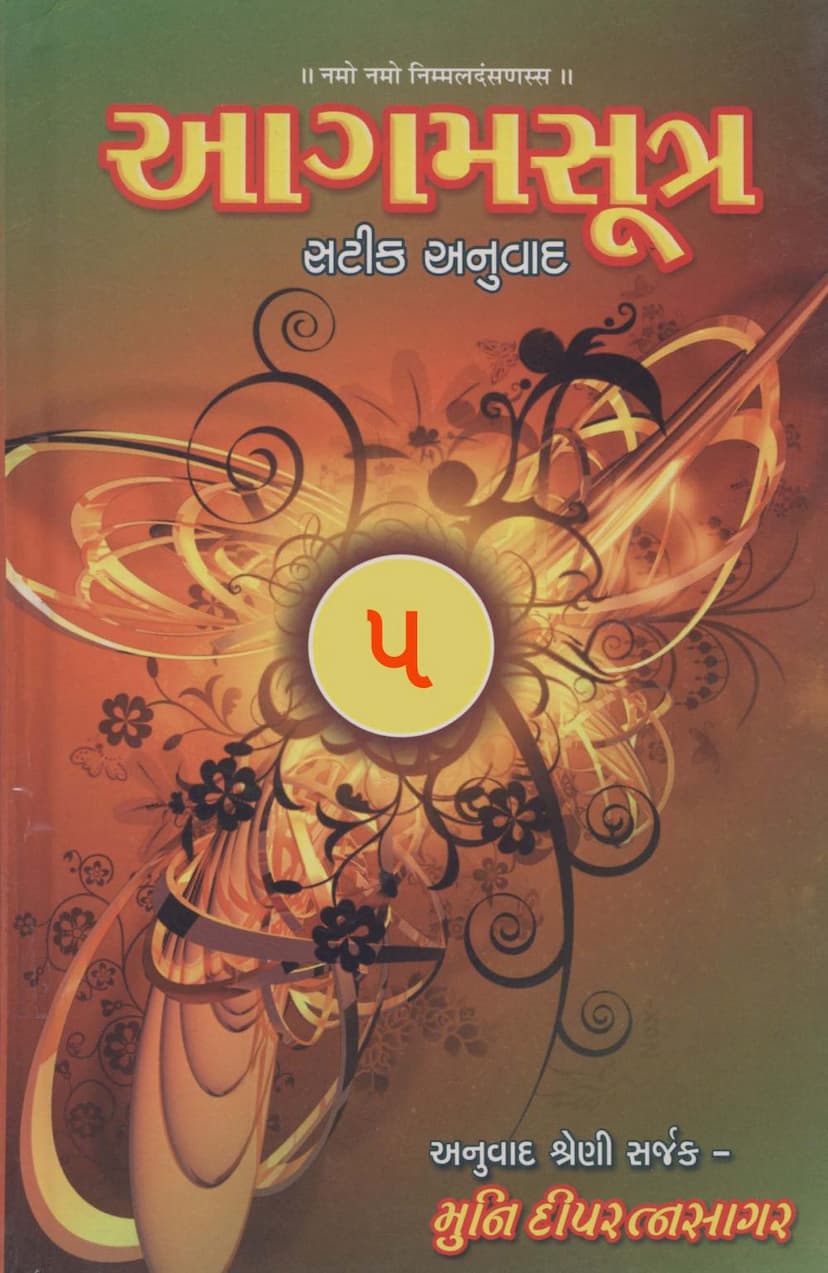Agam Satik Part 05 Sthananga Sutra Gujarati Anuwad 1
Added to library: September 1, 2025

Summary
This is a summary of the provided Jain text, "Agam Satik Part 05 Sthananga Sutra Gujarati Anuwad 1," authored by Dipratnasagar and Deepratnasagar, and published by Deepratnasagar.
The text is the fifth part of a series of Agama Sutra commentaries and translations. Specifically, it focuses on the Sthananga Sutra (also known as Sthānāṅga Sūtra or Thāṇāṅga Sūtra), which is the third Anga Sutra within the Jain Agamas. The original Prakrit name is translated to Sanskrit as "Sthāna," hence the name Sthananga Sutra.
This particular volume, Part 5, covers Sthana (Place) 1 to 3 of the Sthananga Sutra, presenting a commentary and translation. The Sthananga Sutra is noted to be the first Shrutaskandha (collection of scriptures) within the Angas, containing 10 Sthanas (chapters or studies). It is characterized by its presentation of various Jain teachings – relating to Dravyānuyoga (metaphysics), Charanakaranaṇuyoga (conduct and discipline), and Ganitānuyoga (mathematics/astronomy) – in a numerical, concise, and "collection of sayings" (bol-sangrah) format. The text follows a progression from one to ten in its numerical arrangement.
The commentary notes the absence of any specific Niryukti, Bhashya, or Churni for the Sthananga Sutra, but includes the available Vritti (commentary) by Shri Abhaydevsuri. It also highlights the similarity in the presentation method between the Sthananga Sutra and the Samvayanga Sutra, which is the next Anga Sutra.
The provided text then delves into a detailed analysis of the introduction (Bhumika) of the Sthananga Sutra, covering several key points relevant to the study and understanding of this scripture:
- Purpose of the Text (Phala-Shastra): The text emphasizes the importance of stating the fruit or benefit of studying a scripture to motivate listeners and clarify its purpose. The fruit is categorized as immediate (knowledge of the subject matter) and ultimate (attainment of liberation through practice).
- Proper Teacher and Student (Adhikara): The text outlines the eligibility criteria for imparting the Sthananga Sutra, suggesting it should be taught to deserving monks who have completed at least eight years of monastic life, with specific age and training requirements mentioned for other scriptures.
- Mangala (Auspiciousness): It discusses the importance of beginning with auspicious recitations (Mangala) to ensure the smooth and successful completion of the text. This includes considerations of initial, middle, and final auspiciousness, often tied to the respect shown to the Bhagavanta (Lord Mahavir) or the scriptures themselves.
- Samudaya (Community) and Niyoga (Principles of Interpretation): The text explains that the name "Sthananga" is appropriate (Yathartha) as it encompasses the compilation of various "Sthanas" (places or categories). It also details the various meanings and interpretations of the term "Sthana" (place) and "Anga" (limb or part), covering 15 types of "Sthana" and 4 types of "Anga" in their respective philosophical contexts.
- Anuyoga-dvaras (Methods of Interpretation): The text elaborates on the four Anuyoga-dvaras (methods of exposition) that are crucial for understanding the scripture: Upakrama (introduction), Nikshepa (classification), Anugama (sequential exposition), and Naya (philosophical viewpoints). It explains their significance in revealing the meaning of the sutras.
The subsequent sections of the provided text (pages 16 onwards) then detail the exposition of Sthana 1 (Ek Sthan), which focuses on the concept of "one" and its manifestations. This includes the analysis of:
- The Soul (Ātmā): Discussing its oneness from a substance perspective (Dravyaartha) and its multiplicity from a quantitative perspective (Pradeshaartha). It explores the nature of the soul's existence, its presence in different states, and its relationship with various karmic principles.
- Inanimate Substances (Ajiva): Covering aspects like time (Kāla), space (Akasha), and their characteristics, including the "one" nature of Dharma and Adharma Aastikayas.
- Conjugation (Bandha) and Liberation (Moksha): Explaining how souls are bound by karma and the process of liberation.
- Karma Categories: Detailing the eight types of karmas and their specific classifications, such as the eightfold nature of Bandha (attachment) and its causes.
- Punya (Merit) and Papa (Demerit): Discussing their nature and how they influence the soul's trajectory.
- Āshrava (Influx) and Samvara (Abstinence): Explaining how influxes lead to karma binding and how Samvara blocks these influxes, leading to liberation.
- Vedana (Sensation) and Nirjara (Karma Dissipation): Describing how sensations are experienced and how karmas are shed.
- Corporeal Elements (Pudgala): Analyzing the physical aspects of the universe, including their various forms, qualities, and permutations.
- The Living Beings (Jiva): Discussing the classifications of beings based on their sensory perceptions, the nature of their existence, and their spiritual progress through various stages.
- The Cosmology: Detailing the structure of the universe, including the different types of heavens (lokas), realms (dvipas), mountains (parvatas), and rivers (nadis).
- The Ascetics (Shramana) and their Practices: Discussing the three types of ascetics, their vows, conduct, and the specific disciplines they follow.
- The Causes of Karma and their Dissipation: Elaborating on the principles of Āshrava (influx), Samvara (abstinence), and Nirjara (dissipation of karma) in relation to the soul's journey.
- The Nature of Karma: Describing the binding of karma, its dissipation, and the role of intention and action in the karmic cycle.
- The Concept of "One" (Eka): Throughout the text, the concept of "one" (eka) is applied to various aspects, emphasizing the oneness of certain fundamental principles or entities within Jain philosophy.
The text also provides extensive details on the names and classifications of various entities, celestial beings, geographical features of the Jain universe, and the spiritual stages of progress, all presented within the framework of "three" (trividham) or "two" (dvividham) classifications, aligning with the numerical structure of the Sthananga Sutra.
In essence, this volume is a comprehensive and detailed commentary on the initial stages of the Sthananga Sutra, aiming to provide a clear and thorough understanding of its numerical classification and philosophical underpinnings within the Jain tradition.